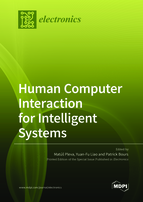Human Computer Interaction for Intelligent Systems
A special issue of Electronics (ISSN 2079-9292). This special issue belongs to the section "Computer Science & Engineering".
Deadline for manuscript submissions: closed (30 September 2021) | Viewed by 72324
Special Issue Editors
Interests: speech recognition; human–computer interaction; voice interaction; automatic broadcast news processing; networking protocols and applications; mobile communications systems; multimodal applications; information security and biometrics
Special Issues, Collections and Topics in MDPI journals
Interests: speech signal processing; audio signal processing; natural language processing; machine learning
Special Issue Information
Dear Colleagues,
The further development of human–computer interaction applications is still in great demand as users expect more natural interactions. For example, speech communication in many languages is expected as a basic feature for intelligent systems like robotic systems, autonomous vehicles, or virtual assistants. For this Special Issue, we invite submissions from researchers addressing the unique opportunities and challenges associated with human–computer interaction with intelligent systems. We encourage authors to submit reports describing systems built for different languages and multilingual systems. We also invite submissions from researchers studying the linguistic, emotional, prosodic, and dialogue aspects of speech communication. We welcome submissions describing other input and output modalities, including multimodal systems, fusion/fission algorithms, and deep learning methods. We encourage the authors to report in detail the state-of-art results and data used to build such systems to support development in those areas. The security of advanced communication channels is also important. Modern biometric technologies, including physical and behavioral analysis, may be proposed and evaluated for different interface modalities and applications. The rapidly growing domain of virtual reality applications is of interest both as an application domain in which new interfaces and methods of interaction are needed and as a potential testbed for evaluating speech and other interface modalities.
This Special Issue aims to cover recent advances in aspects of Human–Computer Interaction for Intelligent Systems, including theory, tools, applications, testbeds, human factors studies, and field deployments. Reviews and surveys of the state-of-the-art in HCI for Intelligent Systems are also welcomed.
Topics of interest to this Special Issue include:
human–robot interaction;
interaction in virtual/augmented reality;
multilingual speech processing;
multimodal HCI;
deep learning in HCI/IS;
EEG in HCI;
biometrics in HCI;
human factors of HCI;
speech recognition;
speech synthesis;
natural language processing;
linguistics; anticipation in speech;
emotion and mood analysis;
prosodic and phonetics;
microphone arrays;
accessible computing.
However, please do not feel limited by these topics, we will consider submissions in any area of HCI for Intelligent Systems.
Dr. Matus Pleva
Prof. Dr. Yuan-Fu Liao
Prof. Dr. Patrick Bours
Guest Editors
Manuscript Submission Information
Manuscripts should be submitted online at www.mdpi.com by registering and logging in to this website. Once you are registered, click here to go to the submission form. Manuscripts can be submitted until the deadline. All submissions that pass pre-check are peer-reviewed. Accepted papers will be published continuously in the journal (as soon as accepted) and will be listed together on the special issue website. Research articles, review articles as well as short communications are invited. For planned papers, a title and short abstract (about 100 words) can be sent to the Editorial Office for announcement on this website.
Submitted manuscripts should not have been published previously, nor be under consideration for publication elsewhere (except conference proceedings papers). All manuscripts are thoroughly refereed through a single-blind peer-review process. A guide for authors and other relevant information for submission of manuscripts is available on the Instructions for Authors page. Electronics is an international peer-reviewed open access semimonthly journal published by MDPI.
Please visit the Instructions for Authors page before submitting a manuscript. The Article Processing Charge (APC) for publication in this open access journal is 2400 CHF (Swiss Francs). Submitted papers should be well formatted and use good English. Authors may use MDPI's English editing service prior to publication or during author revisions.








